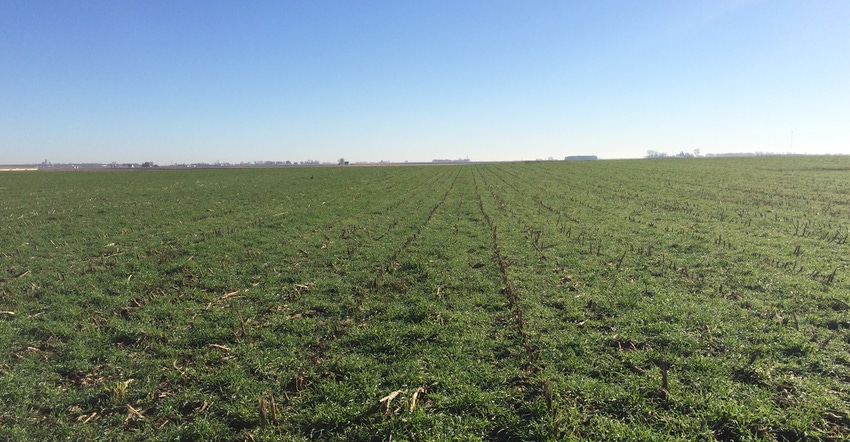Cattle could suffer from bloat when grazing on legumes a day or two after a hard frost.
October 21, 2019

This is the time of year when temperatures dip below or come close to freezing across Iowa. What does this mean for forage crops, particularly forage crops such as sudangrass, sorghum and sorghum sudangrass hybrids?
A frost event, even a light frost, with sudangrass, sorghum and sorghum sudangrass hybrids causes prussic acid to build up in the forage. Special steps should be taken to manage the forage to prevent prussic acid poisoning with livestock.
Steve Barnhart, retired Iowa State University Extension forage specialist, wrote these helpful articles Prussic Acid Poisoning Potential in Frosted Forages and Flurry of Forage Questions Come with First Fall Frost and Freeze. The articles include timely tips on how to manage frosted forages.
Be careful with sorghum-sudan forages
Key points Barnhart shares in these articles on managing frosted forages, such as sudangrass, sorghum and sorghum sudangrass hybrids, include:
Do not graze on nights when frost is likely. High levels of the toxic compounds are produced within hours after a frost.
Immediately after frost, remove the animals until the grass has dried thoroughly. Generally, the forage will be safe to feed after drying five to six days.
Do not graze wilted plants or plants with young tillers or new regrowth. If new shoots develop after a frost, they will have high poisoning potential. Sudangrass should not be grazed until the new growth is at least 18 to 20 inches (24 to 30 inches for sorghum-sudangrass).
Frosted or frozen forage should be safe once baled as dry hay. The forage can be mowed any time after a frost. It is very rare for dry hay to contain toxic levels of prussic acid. If the hay was not properly cured, it should be tested for prussic acid content before feeding.
Waiting five to seven days after a frost to chop frosted forage for silage will limit prussic acid risks greatly.
Delay feeding silage for eight weeks after ensiling.
Remove animals from field
“The first few frosts raise the potential for prussic acid poisoning with sorghum-forages,” says Brian Lang, ISU Extension field agronomist in northeast Iowa. “When grazing or green-chopping forage species that have prussic acid potential, you should avoid grazing on nights when frost is likely. High levels of prussic acid are produced within hours after a frost. Remove animals from the field if a frost is predicted. If a frost occurs, do not re-introduce animals to the field until the forage has dried thoroughly and has turned a light-tan color.”
Without the occurrence of a killing frost (28 degrees F), fall-harvested sorghum-sudan forages will still try to regrow, Lang says. This regrowth will contain high levels of prussic acid. So, after harvest, keep livestock off these fields until after a killing frost that will turn the plant tissue from wet, dark-green to black and then a tan-gray color. This usually takes five to seven days. Once at the tan-gray color, the forage is safe to graze.
Managing prussic acid potential
Prussic acid content decreases dramatically during the hay drying process or ensiling, Lang notes. When ensiling frosted sorghums or sudangrass, it’s suggested to wait about five days after the frost before chopping to get past that elevated rise in prussic acid produced following a frost. Although, as long as you follow good ensiling practice and allow for full fermentation of the silage (at least eight weeks from harvest to feeding), the prussic acid content in the end product is greatly reduced. Testing the feed to determine prussic acid potential prior to feeding is advised.
“If you can achieve a dry hay product, the hay curing process rids the plant of most of the prussic acid content,” he says. “The difficulty, of course, is to achieve dry hay in October.” Also, with poor drying conditions for a hay option, “harvesting forage as baleage could be considered.”
Alfalfa, frost and final harvest
An alfalfa killing frost is around 24 to 25 degrees. Maybe some low spots in northeast Iowa got this cold for a short time during the weekend of Oct. 11 when the temperature dropped below freezing in northern and western Iowa.
“More likely a region-wide northeast Iowa killing frost occurs closer to Oct. 27, and farther south in northeast Iowa in mid-November — the Highway 20 region,” Lang says. “However, you should still be cautious of light frosts and heavy morning dews in that they can create an environment for slightly higher bloat potential with cattle grazing in early morning.”
He adds, “For northeast Iowa, from the Minnesota state line down to about the Highway 20 region, regardless of a killing frost the weekend of Oct. 12-13, or even in late October or mid-November, the remaining alfalfa growing degree days for the 2019 growing season are so few that you can proceed to harvest the alfalfa anytime you have a fair harvest window.
“Try to leave some stubble height — up to 6 inches is preferred, at least 4 inches if you can — to help catch snow and insulate the stand overwinter. Farther south, such as the Highway 30 region across central Iowa, the warmer weather and calculated growing degree day accumulations suggest that it’s best to wait until about Oct. 21 before cutting.”
Source: ISU, which is responsible for the information provided and is wholly owned by the source. Informa Business Media and subsidiaries aren’t responsible for content.
You May Also Like
.png?width=300&auto=webp&quality=80&disable=upscale)

.png?width=300&auto=webp&quality=80&disable=upscale)
